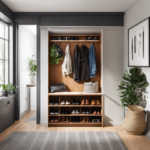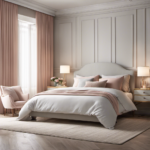Decor
How to Decor a Studio Apartment

Step into the stylish and savvy world of studio apartment decor! Discover the secrets to transforming your compact living space into a haven of comfort and style.
From choosing the right furniture to maximizing storage space, you’ll unlock the key to creating separate zones and utilizing vertical space.
With the addition of multifunctional pieces and personal touches, you’ll marvel at how easy it is to make your studio apartment feel like home sweet home.
Let’s delve into the art of studio apartment decor and make your space truly shine!
Key Takeaways
- Consider size and functionality of furniture
- Utilize vertical space efficiently
- Incorporate multifunctional furniture
- Add personal touches to reflect your style and personality
Choosing the Right Furniture
When choosing furniture for your studio apartment, make sure to consider the size and functionality of each piece.
In a small space, it is crucial to utilize every inch wisely. Look for space-saving solutions, such as a sofa that can be converted into a bed or a coffee table with hidden storage compartments. Opt for multi-purpose furniture that serves more than one function.
For example, a desk that can also be used as a dining table or a bookshelf that doubles as a room divider. Additionally, pay attention to furniture arrangement. Think about the flow of the space and how each piece will fit together.
Consider using floating shelves or wall-mounted storage to free up floor space. By carefully selecting and arranging your furniture, you can create a functional and stylish studio apartment that maximizes every inch of space.
Maximizing Storage Space
Are you tired of feeling like you’re drowning in clutter? Well, fear not! In this discussion, we will explore two key points that will help you maximize your storage space and keep your apartment organized.
Vertical shelving solutions are a great way to take advantage of the often overlooked vertical space in your apartment. Wall-mounted shelves and tall bookcases can provide ample storage without taking up valuable floor space. By utilizing these options, you can create more room for your belongings and keep them organized and easily accessible.
In addition to vertical shelving, incorporating multifunctional furniture is another effective strategy for maximizing your space. Storage ottomans and convertible sofas are perfect examples of furniture pieces that can serve dual purposes. They not only provide a comfortable seating or resting area but also offer hidden storage compartments to keep your belongings out of sight.
Vertical Shelving Solutions
To maximize space in your studio apartment, consider using vertical shelving solutions. Vertical shelving not only helps you utilize the limited floor space efficiently but also adds a touch of style to your living area. Here are three creative ideas for vertical shelving:
-
Hanging planters: Bring the beauty of nature indoors by hanging planters on your vertical shelves. Not only will they add a pop of color, but they will also freshen up the air in your apartment.
-
Wall-mounted desks: Optimize your workspace by installing a wall-mounted desk on one of your vertical shelves. This functional solution allows you to have a designated work area without sacrificing precious floor space.
-
Floating shelves: Create an organized and visually appealing display by installing floating shelves. Use them to showcase your favorite books, decorative items, or even store small kitchen essentials.
By incorporating these vertical shelving solutions into your studio apartment, you can make the most of your space while adding a personal touch.
Now let’s explore some multifunctional furniture ideas that will further enhance your living area’s functionality and aesthetics.
Multifunctional Furniture Ideas
Maximize your space and add versatility to your living area with these multifunctional furniture ideas.
When you’re dealing with a small studio apartment, every inch counts. That’s where space-saving solutions and convertible furniture come in handy.
Imagine having a sofa that transforms into a bed with just a few simple adjustments or a coffee table that doubles as a dining table. These innovative designs allow you to make the most of your limited space without compromising on style or functionality.
Not only do they provide extra seating and sleeping options, but they also create a sense of organization and order in your living area. With multifunctional furniture, you can easily transition from lounging to dining, all while maximizing the functionality of your space.
Now, let’s explore how you can create separate zones within your studio apartment.
Creating Separate Zones
When creating separate zones in your studio apartment, utilize furniture placement and room dividers to establish distinct areas for different activities. This will not only optimize your small space but also add a touch of style and functionality to your living area. Here are three ideas to get you started:
-
Bookshelf Divider: Place a tall bookshelf perpendicular to your bed to create a bedroom area. Use the shelves to store books, decorative items, and even clothes, maximizing storage while dividing the space.
-
Curtain Divider: Hang a floor-to-ceiling curtain to separate your living room from your bedroom. This lightweight and flexible option can be easily opened or closed, providing privacy when needed.
-
Screen Divider: Invest in a decorative folding screen to divide your studio into different zones. Not only will it serve as a visual partition, but it can also be used as a decorative element to enhance the overall aesthetic of your apartment.
By utilizing room dividers, you can create distinct areas in your studio apartment, optimizing the available space.
Now, let’s explore another way to maximize your living area by utilizing vertical space.
Utilizing Vertical Space
Make sure you take advantage of the vertical space in your small living area by utilizing wall-mounted shelves and hanging organizers. When working with a limited floor space, it is crucial to maximize every inch available.
By installing wall-mounted shelves, you not only create additional storage but also free up valuable floor space. These shelves can be used to display decorative items or store everyday essentials, keeping them within reach yet out of the way.
Hanging organizers, such as pocket organizers or hanging baskets, can be used to store smaller items like keys, mail, or even plants, further optimizing the vertical space.
Additionally, incorporating natural light into your studio apartment is key to creating an open and airy atmosphere. Utilize sheer curtains or blinds to allow sunlight to filter through, making the space feel larger and more inviting.
Now, let’s explore how incorporating multifunctional pieces can further maximize your small living area…
Incorporating Multifunctional Pieces
Now that you’ve learned how to utilize vertical space in your studio apartment, let’s move on to incorporating multifunctional pieces that can maximize both storage and functionality.
In a small space, it’s important to make every item count. Consider investing in furniture that can serve multiple purposes. For example, a sofa with built-in storage or a coffee table that can also function as a desk. By choosing these dual-purpose pieces, you can save space and keep your apartment organized.
Additionally, room dividers can be a great way to create separate areas within your studio. You can choose from options like bookshelves, curtains, or folding screens to divide your space while adding visual interest. These dividers not only provide privacy but also act as storage solutions.
Now, let’s move on to adding personal touches to make your studio truly feel like home.
Adding Personal Touches
To make your studio feel like home, try adding personal touches such as family photos or artwork that reflect your unique style and personality. Expressing your individuality through these personal collections can truly transform your space.
Here are three ideas to showcase your personal collections:
-
Display a gallery wall: Create a focal point in your studio by arranging a collection of framed photographs or artwork on one wall. Mix and match different sizes and frames to add visual interest.
-
Show off your travel souvenirs: Arrange your favorite souvenirs from your travels on a shelf or in a glass display case. Not only will this showcase your adventures, but it will also serve as a great conversation starter.
-
Incorporate sentimental items: Whether it’s a childhood toy or a cherished heirloom, including sentimental items in your decor will not only add a personal touch but also evoke happy memories.
Frequently Asked Questions
What Are Some Tips for Choosing the Right Color Scheme for a Studio Apartment?
When choosing the right color scheme for your studio apartment, consider color psychology and popular color combinations. Understanding how colors affect mood and using complementary hues can create a harmonious and visually appealing space.
How Can I Make the Most of My Studio Apartment’s Natural Light?
To make the most of your studio apartment’s natural light, maximize its potential by strategically placing mirrors to reflect and amplify the sunlight. Utilize sheer curtains to allow the light to flow through your windows, creating an airy and bright space.
Are There Any Specific Furniture Arrangements That Work Best in a Studio Apartment?
To optimize your space in a studio apartment, consider furniture placement that maximizes functionality and flow. Experiment with different layouts, like floating your couch to create distinct living areas, and utilize multi-purpose pieces for added versatility.
What Are Some Creative Ways to Incorporate Plants Into a Small Space?
Incorporate plants into your small space with creative solutions like vertical gardening and hanging planters. These techniques allow you to bring nature indoors while maximizing your limited space. Get ready to transform your studio apartment into a green oasis!
How Can I Create a Cozy and Inviting Atmosphere in My Studio Apartment?
To create a cozy and inviting atmosphere in your studio apartment, focus on creating a functional layout and utilizing multi-functional furniture. This will maximize your space and make it feel warm and welcoming.
Conclusion
Congratulations! You’ve successfully transformed your studio apartment into a stylish and functional space that truly reflects your personality.
By carefully selecting furniture, maximizing storage, creating separate zones, utilizing vertical space, and incorporating multifunctional pieces, you’ve expertly optimized every inch of your home.
With a few personal touches sprinkled throughout, your studio now feels like a cozy haven that perfectly suits your needs.
So sit back, relax, and enjoy the fruits of your hard work. Your studio apartment is now the envy of all who enter, a testament to your impeccable taste and ingenuity.
- About the Author
- Latest Posts
Meet Bethia, the visionary designer at ByRetreat who brings a touch of magic to every remote workspace she creates. With a boundless imagination and an eye for beauty, Bethia is passionate about transforming ordinary spaces into extraordinary havens of creativity and comfort.
Bethia possesses a unique talent for envisioning the perfect combination of furniture, colors, and textures that harmonize seamlessly in a room. She understands that selecting furniture goes beyond mere functionality; it’s about curating pieces that evoke a sense of style and sophistication while enhancing the overall ambiance.
Decor
Step-by-Step Guide to Creating a Stunning Brick Wall Accent
Achieve a unique, industrial-chic look in your home with this comprehensive guide to creating a stunning brick wall accent from scratch.
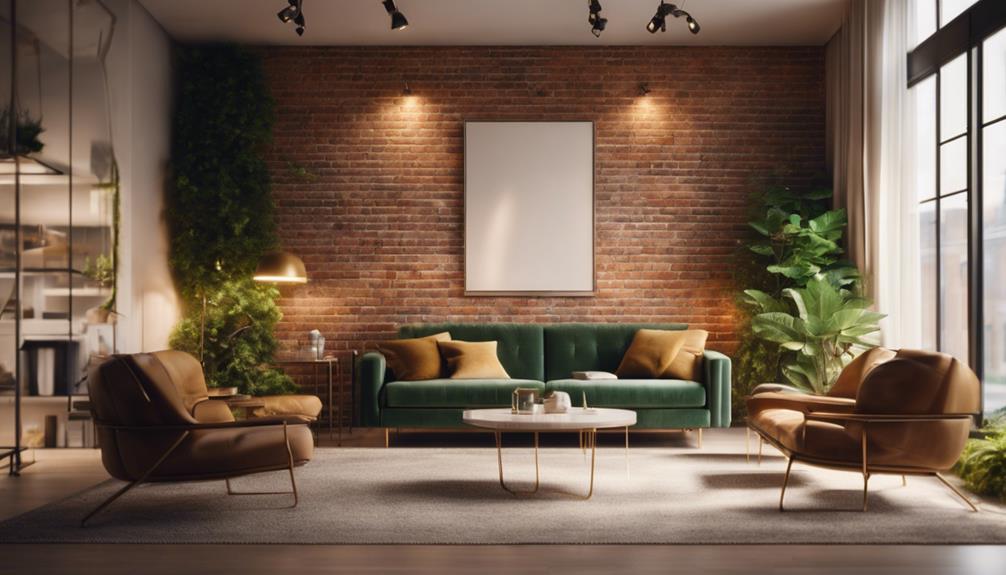
We're about to start on a transformative project: crafting a stunning brick wall accent that adds depth, texture, and visual appeal to any room. To get started, we'll gather essential materials like high-quality brick veneer, a grout bag, and necessary tools. Next, we'll prepare the wall surface, making sure it's clean and even. Then, we'll initiate and trace the design, taking precise measurements to guarantee accuracy. We'll add texture with spackle and achieve a distressed look by exposing the bricks to the elements. Finally, we'll prime, paint, and finish the wall, blending corners and edges for a seamless look. Let's delve into the details to create a truly stunning accent wall.
Key Takeaways
• Prepare the wall surface by ensuring it's clean, even, and applying adhesive according to the manufacturer's instructions.
• Project and trace the design onto the wall using a projector and pencil or chalk for accurate visualization and measurement.
• Add texture and a distressed look by applying spackle, manipulating it for unique effects, and exposing the bricks to the elements for a natural patina.
• Paint the brick wall accent with a masonry primer and a chosen paint color, applying it evenly with a roller and blending corners and edges for a seamless look.
• Inspect the finished wall accent for a flawless finish and maintain it accordingly to ensure its longevity.
Gathering Essential Materials
We'll need to gather the following essential materials to create a stunning brick wall accent that exceeds our expectations. For a professional-looking result, we can't skimp on the quality of our materials.
First, we'll need a high-quality brick veneer that will be the star of the show.
Next, we'll require a grout bag to apply the grout between the bricks, guaranteeing a seamless finish.
To cut our bricks to size, we'll need a saw with a diamond blade, which will make quick work of even the toughest bricks.
Additionally, we'll need a clean 5-gallon bucket to mix our grout and a trowel to apply it. Other necessary materials include Omnigrip adhesive, a level, tape measure, paint stir stick, brick jointer, gloves, and painters plastic for mess prevention.
With all these materials at our disposal, we'll be well on our way to creating a stunning brick wall accent that will elevate any room. By taking the time to gather all the necessary materials, we'll set ourselves up for success and secure a smooth, efficient process.
Preparing the Wall Surface
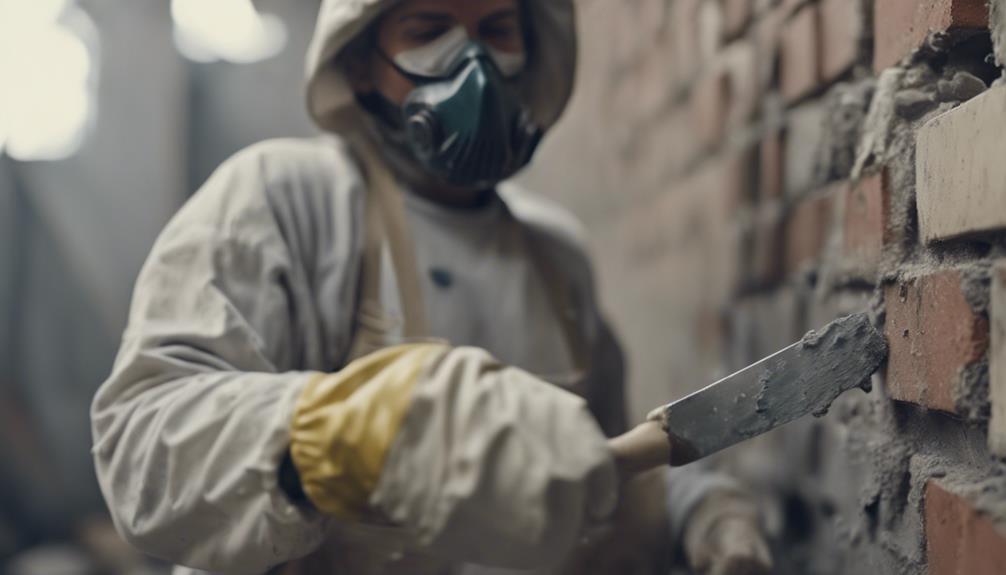
Cleaning the wall surface of any debris, dirt, or dust is the essential first step in preparing it for brick installation, ensuring a strong bond between the brick veneer and the wall. We need to make sure the surface is spotless to prevent any obstacles that might affect the adhesive properties of the brick.
Next, we'll use a level to check the wall for any uneven spots or imperfections that may impact the brick installation. This step is vital to guarantee a smooth and even application of the brick.
Once we've confirmed the wall is level, we'll apply a suitable adhesive or mortar to the wall surface according to the manufacturer's instructions. This will create a strong bond between the brick and the wall.
Before we begin the installation process, we'll also consider using a protective covering or drop cloth to prevent messes and protect the surrounding area.
Projecting the Brick Pattern
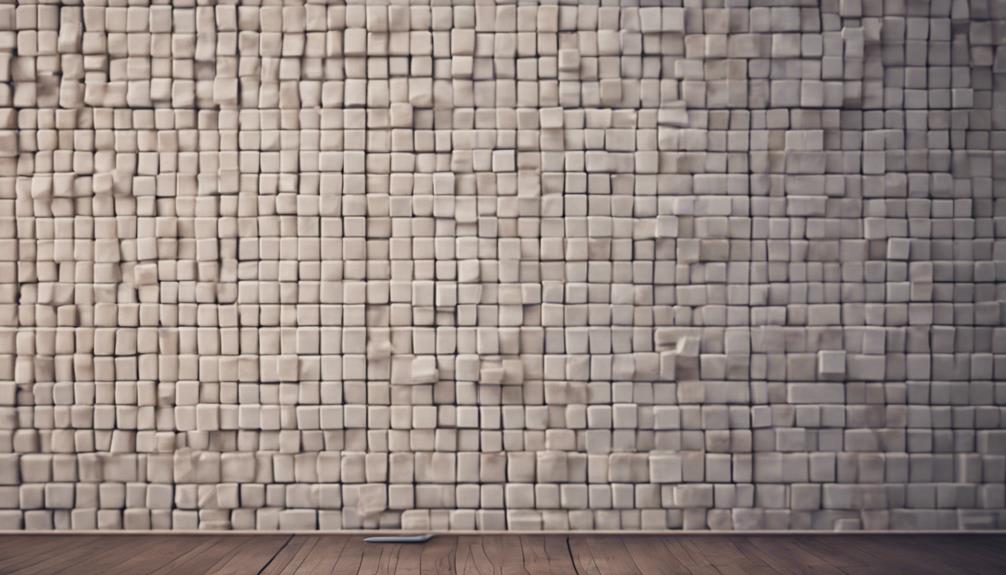
With our wall surface prepared, we're ready to visualize the brick pattern, and a projector will be our best friend in this step. We'll use it to display the brick pattern onto the wall, guaranteeing accurate placement.
First, we'll position the projector at the right distance and angle to get a clear projection. Then, we'll adjust the size and alignment of the projected image to fit our wall dimensions. This will provide us with a precise guide for our brick installation.
We'll take a moment to double-check that the projected image is centered and even, making any necessary adjustments before moving forward. With our pattern projected, we can now trace the design onto the wall using a pencil or chalk. This will give us a precise outline to follow as we begin installing our bricks.
Tracing the Design Accurately

As we move forward with tracing the design accurately, we'll need to focus on three key points: designing the pattern, marking the wall, and measuring accurately.
By carefully considering these elements, we'll guarantee that our brick wall accent turns out stunning and precise.
Designing the Pattern
Having a projector helps us to accurately trace the brick wall design onto the surface, ensuring our pattern is precise and visually appealing.
When designing the pattern, precision is key to achieving a professional-looking brick accent wall. We take our time to carefully trace the pattern, ensuring proper alignment and spacing of the bricks.
Using a projector allows us to transfer a detailed and consistent design onto the wall, which is essential for a stunning brick accent wall. Recognizing that precision in tracing the design will result in a visually appealing final product.
Rushing through this step can lead to errors during the installation process, which is why we take the time to get it right. By tracing the pattern accurately, we can achieve a beautiful brick accent wall that adds character and style to any room.
With precision and patience, we can create a design that will impress.
Marking the Wall
Before we start tracing the design, we level the wall and take precise measurements to guarantee our brick accent wall turns out perfectly aligned and visually stunning. To guarantee accuracy, we use a level and tape measure to mark the dimensions of the accent wall precisely. This step is essential, as it sets the foundation for a cohesive and professional-looking finish.
| Step | Action | Tips |
|---|---|---|
| 1 | Level the wall | Ensure the wall is even and plumb |
| 2 | Measure dimensions | Use a tape measure to record precise measurements |
| 3 | Mark the design | Trace the design accurately, paying attention to corners and edges |
We double-check our measurements and markings to avoid any mistakes that could impact the overall appearance of our brick accent wall. By taking our time and being meticulous, we can create a stunning feature wall that adds visual interest to any room.
Measuring Accurately
By taking precise measurements, we ensure that our brick accent wall design is accurately translated onto the wall, enabling us to visualize the final look of our stunning feature wall.
To achieve this, we use a tape measure to guarantee accuracy in our measurements. By doing so, we can determine the exact size and layout of our brick accent wall, guaranteeing a seamless design that fits perfectly with the wall dimensions.
Tracing the design accurately on the wall helps us visualize the final look of our brick accent wall, making it easier to make any necessary adjustments before starting the installation process. Taking accurate measurements is essential for ensuring the bricks fit perfectly and the design is symmetrical.
Precision in measuring and tracing the design ensures a professional and visually appealing brick accent wall. With accurate measurements, we can confidently begin the installation process, knowing that our stunning brick accent wall will turn out exactly as envisioned.
Adding Texture With Spackle
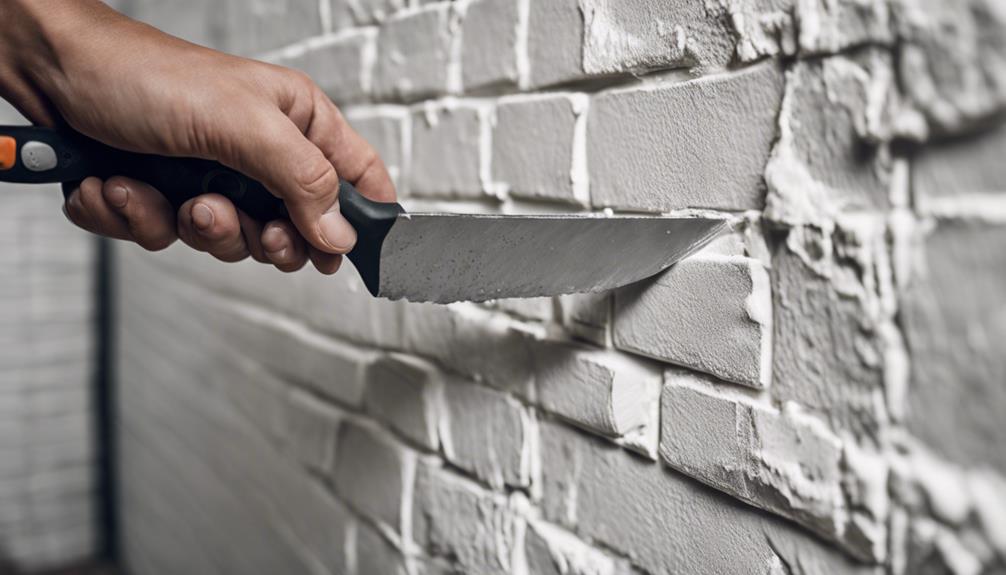
Frequently, we find that spackle is an ideal material for adding texture to a brick wall, as it can be manipulated to achieve a wide range of effects. By applying spackle generously and strategically, we can create unique textures and patterns on the brick surface.
To achieve the desired texture, we can use tools like putty knives to manipulate the spackle and create varying effects.
Some techniques to try include:
- Dabbing the spackle onto the brick wall to create a rough, irregular texture
- Scraping the spackle with a putty knife to create a smooth, even texture
- Building up layers of spackle to create a raised, three-dimensional effect
- Using different tools, such as a trowel or a sponge, to create unique textures and patterns
Achieving a Distressed Look
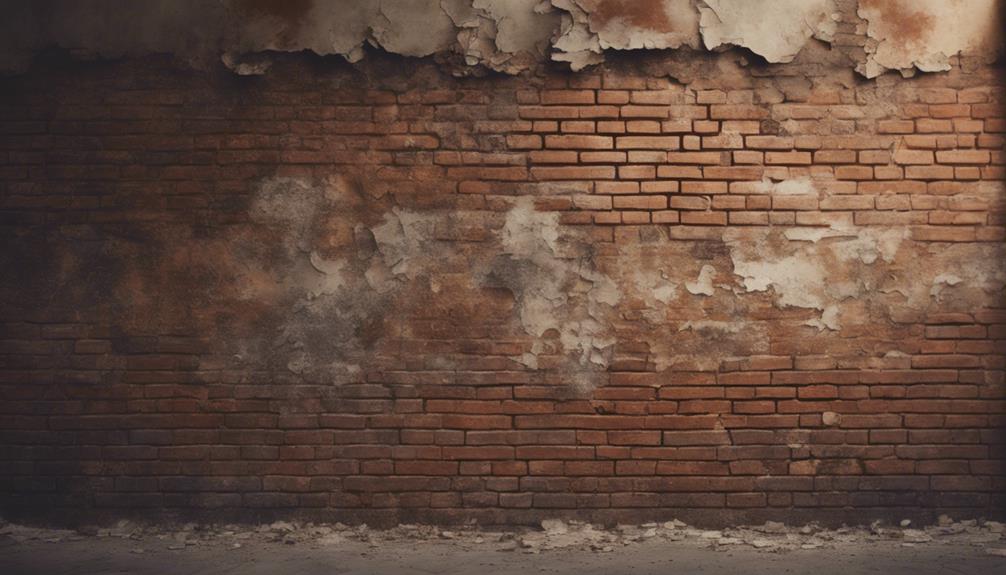
As we delve into the world of achieving a distressed look for our brick wall accent, we'll explore the finer points of creating an authentically worn appearance.
We'll discuss how to age the bricks naturally, emphasizing faded spots to give our accent wall a truly vintage vibe.
Aging the Bricks Naturally
We can replicate the natural aging process by exposing our bricks to the elements, allowing them to develop a rich, distressed look over time. This process can take months, even years, but the result is well worth the wait. As our brick wall is exposed to the sun, rain, and wind, it will begin to develop a unique patina that adds character and authenticity to our accent wall.
Some of the natural effects we can expect to see include:
- Moss, lichen, and efflorescence forming on the bricks, adding texture and visual interest
- Weathering and wear that creates a worn, aged appearance
- Cracks, chips, and discoloration that add to the distressed look
- Unique patterns and textures that develop over time, giving our brick wall a one-of-a-kind charm
Emphasizing Faded Spots
To take our naturally aged brick wall to the next level, we'll emphasize the faded spots, strategically applying paint to create a distressed look that adds character to our accent wall.
Using a dry brush technique, we'll lightly apply paint to the faded areas, creating a weathered appearance that adds depth and texture to our wall. By blending the corners with a heavier coat of paint, we'll enhance the distressed effect, making our wall look like it's been around for years.
To achieve this look, we'll need to plan out the placement of the faded areas carefully. We can use a projector or our drawing skills to map out the design, ensuring a cohesive distressed look.
Painting the Brick Accent Wall

We're ready to transform our brick accent wall with a fresh coat of paint, but first, we need to prime it with a high-quality masonry primer to guarantee the paint adheres properly. This vital step ensures a strong bond between the paint and the brick, preventing peeling or flaking over time.
To achieve a stunning brick accent wall, we'll follow these essential steps:
- Choose a paint color that complements our room's decor and style, considering darker colors for a dramatic look.
- Select a breathable masonry paint to allow moisture to escape from the brick and prevent peeling or bubbling.
- Apply paint using a high-quality roller for even coverage, and consider using a brush for hard-to-reach areas and grout lines.
- Allow the paint to fully dry between coats and consider adding a clear sealant for added protection and durability.
Blending Corners and Edges

After priming and painting our brick accent wall, we're ready to tackle the often-overlooked details that make all the difference: blending corners and edges. This pivotal step guarantees a seamless look across the entire wall.
To achieve this, we'll employ a specific paint technique. When corner blending, we'll apply a heavier coat of paint and gradually fade it towards the center of the wall, creating a smooth shift. Along the edges, we'll use light strokes and a dry brush technique to create a distressed effect, adding character to our brick wall.
It's crucial to pay attention to detail when painting corners and edges to maintain a cohesive look. We'll apply paint lightly on the corners to avoid a heavy or unnatural appearance that may disrupt the overall aesthetic.
To guarantee accuracy, we can utilize a projector or drawing skills to accurately trace and blend corners and edges for a professional finish.
Finishing Touches and Inspection
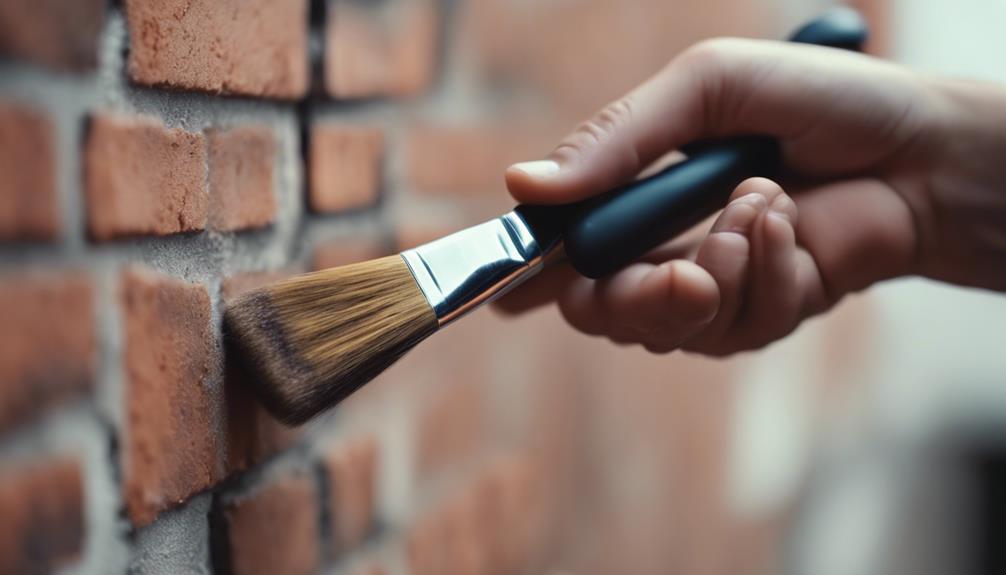
We inspect every inch of our brick accent wall, scrutinizing each brick and joint to guarantee a flawless finish. This final step is essential in ensuring our hard work pays off.
As we examine the wall, we're checking for any loose bricks or grout, making sure everything is stable and secure.
Here are some key things we're looking for:
- Loose bricks or grout that need to be resecured
- Signs of damage or wear and tear that require maintenance or touch-ups
- Areas that need a good cleaning to maintain the wall's appearance and longevity
- Whether sealing the brick wall is necessary for added protection against stains and moisture.
Frequently Asked Questions
How Can I Make My Brick Wall More Attractive?
We want to make our brick wall more attractive, and rightfully so! To achieve this, we can add texture with different brick colors or patterns, strategically use lighting to highlight the texture and depth, and incorporate decorative elements like shelves, artwork, or plants.
We can also experiment with finishes like whitewashing or sealing for a customized look. By doing so, we'll create a visually appealing space that showcases our brick wall's unique character.
How Do You Make a Brick Wall Effect on a Wall?
We achieve a brick wall effect on a wall by using thin brick panels or brick veneer for a realistic look.
We apply mastic or tile adhesive to the back of each panel and affix them to the wall, guaranteeing a secure installation.
We use a level to confirm straight rows and a seamless appearance.
How Do You Make a Realistic Faux Brick Wall?
We've found that creating a realistic faux brick wall involves more than just slapping on some brick veneer panels.
To achieve an authentic look, we investigate the importance of subtle details. By applying spackle to fill in gaps and create a distressed effect, we can mimic the imperfections of real brick.
Additionally, using a projector to trace a brick pattern guarantees accurate placement, while drywall screws provide a durable finish.
How Do You Decorate a Brick Accent Wall?
We approach decorating a brick accent wall by striking a balance between showcasing its rustic charm and incorporating complementary elements.
We opt for minimalist decor to let the brick take center stage, while strategic lighting fixtures highlight its texture and depth.
Adding pops of color through wall hangings or plants creates a striking contrast, and thoughtfully arranged furniture enhances the overall aesthetic.
Conclusion
As we step back to admire our handiwork, we're reminded of the ancient Greeks' concept of 'meraki' – pouring love and care into our creations.
Our brick accent wall, with its textured, distressed beauty, is a confirmation of the power of attention to detail. Like a masterpiece of trompe l'oeil, it deceives the eye, inviting the viewer to touch, to explore.
And as we walk away, we're certain that our labor of love has created something truly remarkable – a work of art that whispers, 'I was made with love, and I'll endure.'
- About the Author
- Latest Posts
Introducing Ron, the home decor aficionado at ByRetreat, whose passion for creating beautiful and inviting spaces is at the heart of his work. With his deep knowledge of home decor and his innate sense of style, Ron brings a wealth of expertise and a keen eye for detail to the ByRetreat team.
Ron’s love for home decor goes beyond aesthetics; he understands that our surroundings play a significant role in our overall well-being and productivity. With this in mind, Ron is dedicated to transforming remote workspaces into havens of comfort, functionality, and beauty.
Decor
How to Create a White Brick Accent Wall in 5 Steps
Liven up your space with a stunning white brick accent wall in just 5 simple steps – discover the secrets to transforming your room!
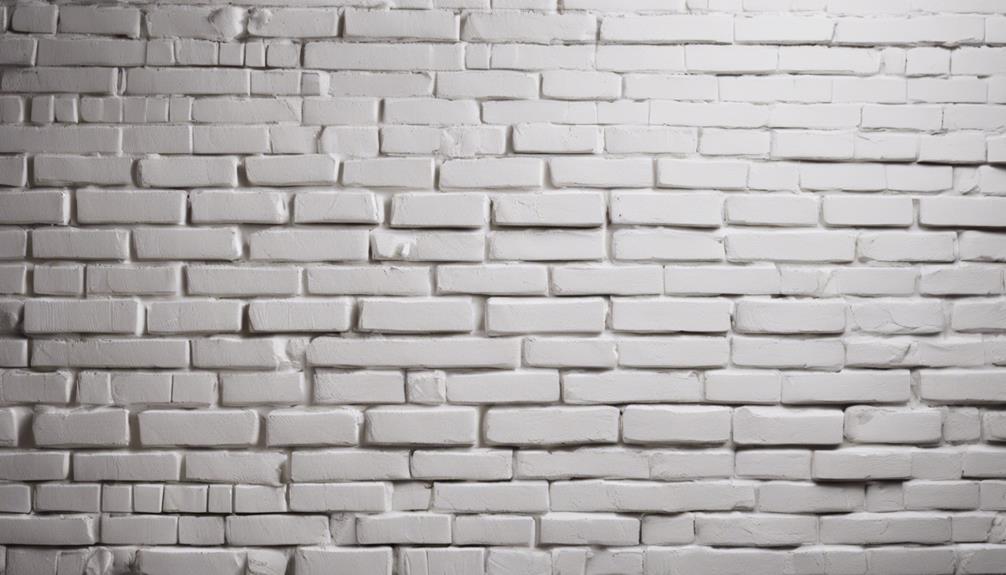
To create a white brick accent wall, start by cleaning and priming the surface. Measure and cut faux brick panels to fit, then dry fit and attach them. Seal the wall with a paint mixture for coverage. Finish by adding corner trim for a polished look. For detailed steps on each process, follow these instructions for a professional outcome.
Key Takeaways
- Clean and prime the wall surface for adhesion.
- Measure, cut, and sand faux brick panels accurately.
- Dry fit panels before applying adhesive and nailing.
- Seal the wall with diluted white paint mixture.
- Add corner trim for a professional finish.
Cleaning and Priming the Wall Surface
- Remove dirt and debris
- Wash with TSP solution
- Sand for smoothness
- Apply primer
- Let dry before painting. –v 6 –ar 16:9
To begin creating your white brick accent wall, start by thoroughly cleaning and priming the wall surface. Before installing the faux brick panels, make sure the wall is free of any dust or dirt by using a damp cloth or mild soap and water. This step is vital to promote proper adhesion of the panels to the wall surface.
Next, prime the wall with a high-quality primer to create a smooth base for the faux brick panels. Using a paint roller or brush, apply the primer evenly, covering the entire wall surface. The primer won't only help the panels adhere better but also ensure a professional and long-lasting finish to your accent wall.
Allow the primer to dry completely as per the manufacturer's instructions before proceeding with the installation of the faux brick panels. Proper cleaning and priming of the wall surface are important steps in this process to guarantee a successful and visually appealing white brick accent wall.
Measuring and Cutting Faux Brick Panels
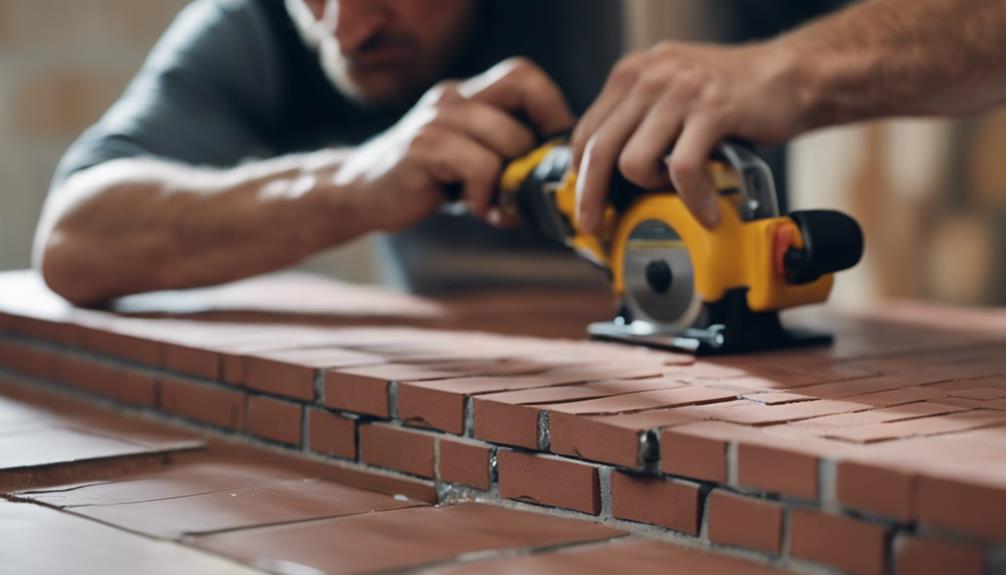
Accurately measure the wall area where the faux brick panels will be installed to guarantee a proper fit. Use a measuring tape to determine the height and width you need to cover.
After measuring, it's time to cut the faux brick panels. Grab a jigsaw or hand saw to precisely cut the panels to the desired size for your faux brick wall. Take into account any obstacles or corners in the space to make certain a seamless fit.
Once cut, sand the edges of the panels for a smooth finish. This step not only enhances the distressed look but also guarantees a professional appearance. Remember, the distressed look adds character to the faux brick wall.
Finally, dry fit the cut panels on the wall before attaching them. This step allows you to check alignment and make any necessary adjustments before permanently securing the panels.
Take your time during the measuring and cutting process to achieve a polished end result.
Dry Fitting and Attaching Panels

Measure and cut faux brick panels to fit the desired area before attaching them to the wall, ensuring a seamless installation process.
To begin, dry fit the panels in place to check alignment and spacing. This step is important to make sure everything fits properly before permanently attaching them.
Once you're satisfied with the positioning, apply construction adhesive to the back of the panels for added support during installation. Securely nail the panels into the studs to create a sturdy and long-lasting attachment to the wall.
When nailing, aim to conceal nail holes effectively by either nailing directly into recessed mortar lines or adding more nails where panels meet. This won't only provide a secure hold but also maintain the aesthetic appeal of your white brick accent wall.
Sealing the Wall With Paint Mixture
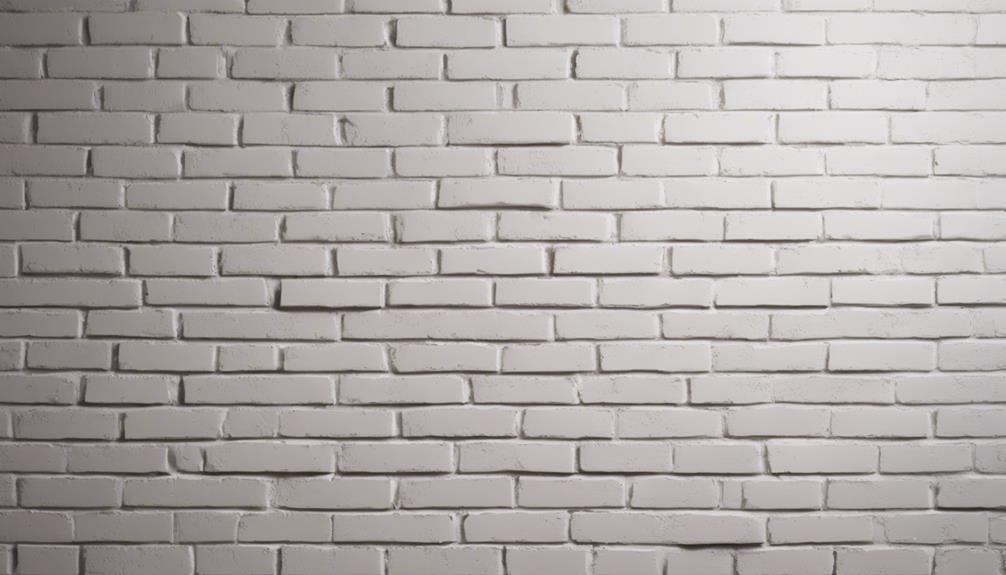
For sealing the faux brick wall, mix white paint with water to create a sealing solution. Dilute the paint mixture to the desired consistency for easy application. Use a paintbrush or roller to evenly apply the sealing solution to the entire wall, guaranteeing complete coverage to seal and protect the faux brick surface. Let the paint mixture dry completely before proceeding with additional layers or decorations.
To help you understand the sealing process better, here is a simple table outlining the steps to seal the faux brick wall with the white paint mixture:
| Steps to Seal Faux Brick Wall |
|---|
| 1. Mix white paint with water |
| 2. Dilute to desired consistency |
| 3. Apply with brush or roller |
| 4. Guarantee complete coverage |
Following these steps will not only seal your faux brick wall effectively but also provide a protective layer that enhances its appearance.
Adding Corner Trim for Finishing Touch
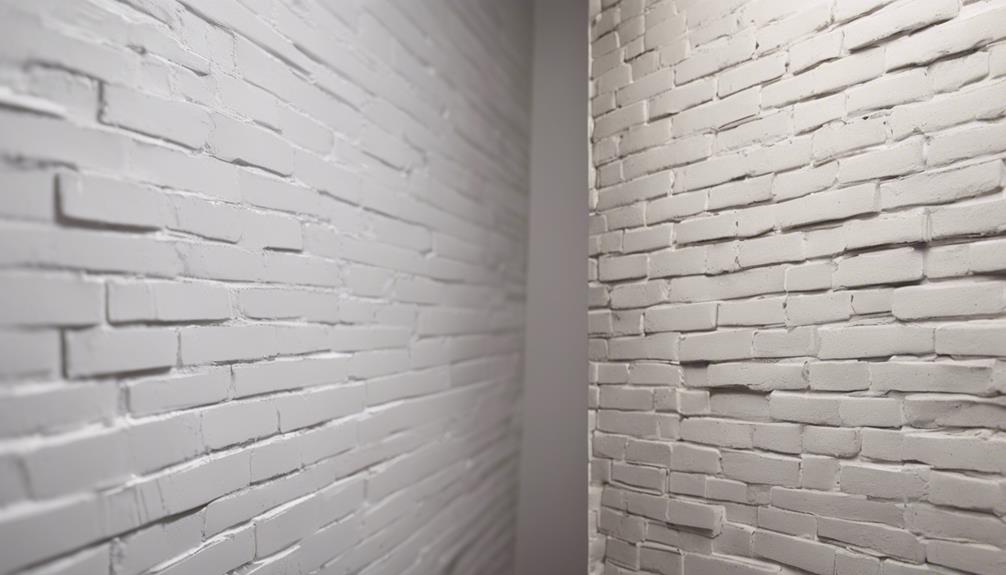
To elevate the overall look of your faux brick accent wall, consider adding corner trim for a polished and professional finishing touch. Here's why corner trim is essential for your project:
- Polished Finish: Corner trim provides a clean connection between the faux brick panels and adjacent walls, giving your accent wall a refined appearance.
- Conceals Imperfections: It helps hide any imperfections or gaps at the corners, ensuring a seamless and flawless look.
- Complements Style: Choose corner trim that complements the style and color of your faux brick panels to create a cohesive and unified design.
- Completes the Look: Properly installed corner trim enhances the overall appearance of your accent wall, providing a professional finish that completes the entire project.
Frequently Asked Questions
How to Create a White Brick Wall?
To create a white brick wall, first, install faux brick panels securely. Fill gaps with drywall mud for a textured look. Paint the bricks white for a modern finish. Seal the wall for durability and easy maintenance.
How to Build a Brick Wall Step by Step?
Measure and mark the wall to guarantee accuracy. Start by attaching the first brick level using screws or adhesive. Fill any gaps with drywall mud for texture. Use grouting sponges to stamp bricks with paint for a realistic finish.
How to Paint a Brick Wall White?
When painting a brick wall white, prep is key. Sanding for smoothness, layering with care, and sealing for protection will guarantee a flawless finish. Remember, a little elbow grease now saves headaches later.
How to Paint Fake Brick White?
To paint fake brick white, use a semi-gloss enamel paint for durability. Lightly sand the surface for better adhesion. Apply multiple coats evenly, allowing each to dry completely. Consider a paint sprayer for a smoother finish.
Conclusion
In just five easy steps, you can transform any room with a stunning white brick accent wall. With a little bit of elbow grease and creativity, you can achieve a stylish and modern look that will impress all your friends and family.
So go ahead, grab those faux brick panels and get ready to showcase your DIY skills with a beautiful accent wall that will be the envy of everyone who sees it!
- About the Author
- Latest Posts
Introducing Ron, the home decor aficionado at ByRetreat, whose passion for creating beautiful and inviting spaces is at the heart of his work. With his deep knowledge of home decor and his innate sense of style, Ron brings a wealth of expertise and a keen eye for detail to the ByRetreat team.
Ron’s love for home decor goes beyond aesthetics; he understands that our surroundings play a significant role in our overall well-being and productivity. With this in mind, Ron is dedicated to transforming remote workspaces into havens of comfort, functionality, and beauty.
Decor
Make Stunning Topiaries in 3 Simple Steps
Master the art of topiary-making in just three easy steps and unlock the secret to creating breathtaking, one-of-a-kind masterpieces.
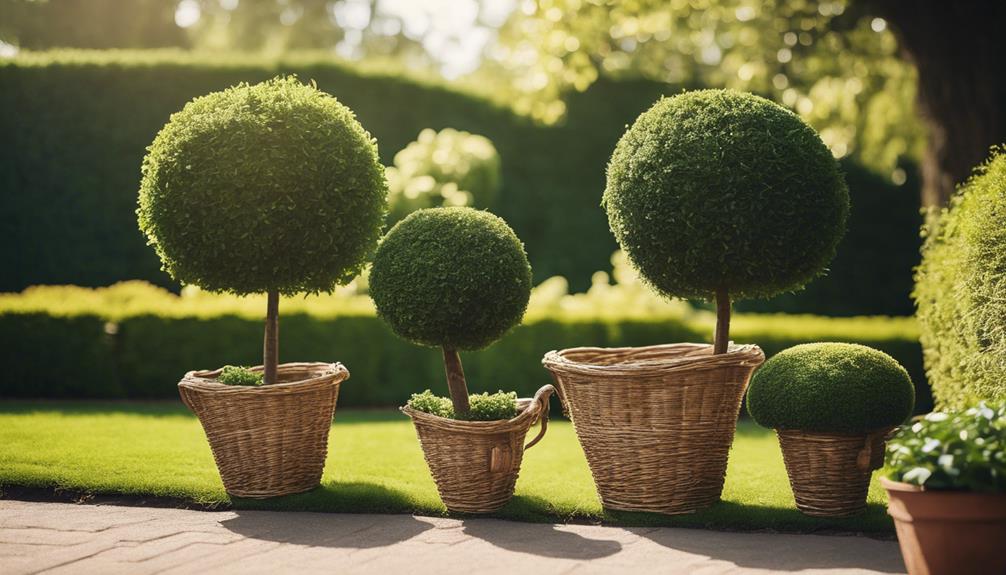
We can create stunning topiaries in just a few simple steps, and with the right materials and techniques, we can bring our unique vision to life and add a touch of elegance to any space. First, we select topiary materials like boxwood, yew, or ivy, and opt for shapes like cones, balls, or spirals. Next, we prepare our dowel rods by sanding and staining them to match our design aesthetic. Finally, we assemble our topiary by attaching high-quality greenery to a sturdy base and customizing with ribbons or flowers. As we work through these steps, our topiary begins to take shape, and the possibilities unfold.
Key Takeaways
• Select topiary materials like boxwood, yew, or privet, considering growth habits and requirements for ideal shaping and trimming.
• Prepare dowel rods by sanding, staining, and anchoring them securely in the base for stability and aesthetic appeal.
• Assemble the topiary by attaching high-quality greenery to a sturdy base, using tools like floral wire and hot glue for a polished look.
• Choose a base that provides a solid foundation, determining the overall structure and appearance of the topiary, and prepare necessary tools.
• Customize the topiary with embellishments like ribbons, flowers, or decorative accents, matching the design aesthetic and color scheme.
Selecting Your Topiary Materials
When choosing shrubs for our topiary project, we opt for varieties like boxwood, yew, privet, or ivy, which are well-suited for shaping and trimming. These plants are perfect for creating intricate designs and shapes, making them ideal for our topiary masterpiece.
To make a stunning topiary, we need to select one that fits our vision. We can choose a shape that complements our outdoor or indoor space, such as a cone, ball, or spiral shape. If we're feeling adventurous, we can even create animal shapes!
Before we start, we need to learn how to make the right selection. Creating a topiary requires careful consideration of the plant's growth habits and requirements. Make sure to research the specific needs of our chosen shrub to guarantee it thrives.
Preparing Your Dowel Rods

Now that we've selected our topiary material, it's time to prepare the dowel rods that will provide the framework for our design. Whether we're creating Topiary Trees for the first time or seasoned pros, preparing our dowel rods is a critical step in bringing our vision to life.
To start, we'll select dowel rods of the appropriate length and thickness for our topiary project. Next, we'll sand them to create a smooth surface for painting or staining, making them a little more receptive to our chosen aesthetic. Speaking of which, we can stain our dowel rods to match the aesthetic of our topiary design, adding an extra layer of cohesion to our project.
As we work, it's vital to keep one hand on the dowel rods, ensuring they're securely anchored in the base of our topiary for stability. Thanks for sharing in our creative journey! With our dowel rods prepared, we're one step closer to crafting a stunning topiary that's sure to impress.
Assembling Your Topiary

With our dowel rods prepared, we're ready to build our topiary by selecting a sturdy base that will provide a solid foundation for our design. This is the most vital step, as it will determine the overall structure and appearance of our topiary.
Here are the essential steps to assemble our topiary:
- Choose the right base: Select a sturdy base, such as a foam ball or cone, to build upon.
- Select high-quality greenery: Pick high-quality faux greenery or live plants that will hold their shape well and complement our design.
- Prepare our tools: Gather tools like floral wire, scissors, and hot glue to secure the greenery to the base.
- Start filling: Begin attaching the greenery to the base, layering different types to create depth and texture in our topiary design.
Now that we've assembled our topiary, it's time to add those finishing touches. We can customize our topiary with embellishments like ribbons, flowers, or decorative accents for a personalized touch.
Next time, we'll be browsing through a website in this browser, searching for inspiration for our next topiary project. But for now, let's take our time to start filling our topiary with life and beauty.
Frequently Asked Questions
How to Make a Topiary for Beginners?
We're thrilled to explore the world of topiaries!
To make a topiary as a beginner, we choose a boxwood or ivy plant, ideal for their dense growth and ease of shaping.
We start with a basic shape like a cone or ball, using wire frames for more intricate designs.
Regular trimming and maintenance are key to keeping our topiary looking neat and well-shaped.
How to Make Topiary Frames at Home?
We're thrilled to explore making topiary frames at home!
Did you know that 70% of gardeners use DIY wire frames to create unique topiaries? We're among them!
To make our own topiary frames, we start by bending and shaping wire into desired shapes like cones, balls, or spirals.
Then, we secure the wire frame together using zip ties and attach it to the plant for shaping.
This way, we can customize our topiary frames to fit specific plant shapes and sizes, igniting our creativity!
What Is the Topiary Technique?
We're thrilled to delve into the world of topiaries!
The topiary technique involves carefully trimming and training plants to create unique shapes or designs. It's an art form that requires patience and attention to detail, as we carefully shape and prune our chosen plants to bring our vision to life.
How to Make a Topiary From an Established Shrub?
We're excited to share how to create a stunning topiary from an established shrub!
First, we prune the shrub by selecting a central stem and clipping offshoots to create the desired shape.
We then encourage outward growth by strategically pruning the shrub to guide its development.
With regular maintenance, our topiary will thrive and maintain its unique shape over time.
Conclusion
We've picked our plants, prepared our dowel rods, and assembled our topiaries. Now, we get to admire our handiwork!
With just three simple steps, we've created stunning topiaries that add a touch of elegance to any space.
We've tamed the wild, shaping our plants into beautiful, uniform forms. And the best part? We did it ourselves, with a little patience and some careful planning.
- About the Author
- Latest Posts
Introducing Ron, the home decor aficionado at ByRetreat, whose passion for creating beautiful and inviting spaces is at the heart of his work. With his deep knowledge of home decor and his innate sense of style, Ron brings a wealth of expertise and a keen eye for detail to the ByRetreat team.
Ron’s love for home decor goes beyond aesthetics; he understands that our surroundings play a significant role in our overall well-being and productivity. With this in mind, Ron is dedicated to transforming remote workspaces into havens of comfort, functionality, and beauty.
-

 Vetted3 days ago
Vetted3 days ago15 Best Printers of 2024: Top Picks and Expert Reviews
-

 Vetted5 days ago
Vetted5 days ago15 Best Tile Sealers for Long-Lasting Protection and Shine
-

 Vetted1 week ago
Vetted1 week ago15 Best Smelling Floor Cleaners That Will Leave Your Home Fresh and Inviting
-

 Vetted1 week ago
Vetted1 week ago14 Best Power Scrubbers for Showers That Will Transform Your Cleaning Routine
-

 Vetted5 hours ago
Vetted5 hours ago15 Best LED Dimmer Switches With No Flicker: Ultimate Guide for a Flicker-Free Lighting Experience
-

 Vetted6 hours ago
Vetted6 hours ago15 Best Evergreen Plants for Shade Gardens: A Complete Guide
-

 Mardi Gras Decoration2 days ago
Mardi Gras Decoration2 days agoWhat Do the Symbols of Mardi Gras Mean?
-

 Appliances5 days ago
Appliances5 days ago5 Best Energy-Efficient Stainless Steel Fridges 2023





